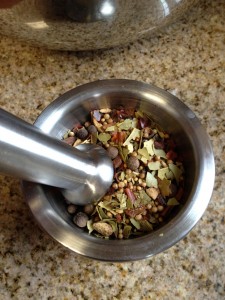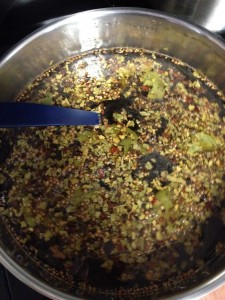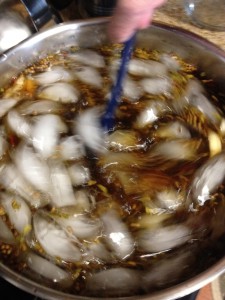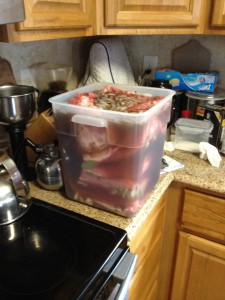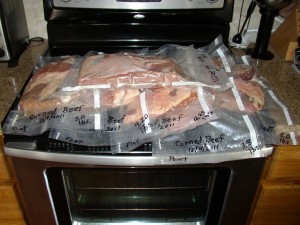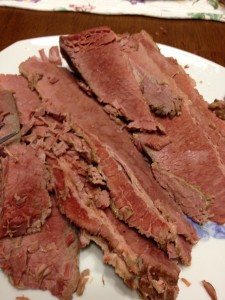Homemade Corned Beef
As I have mentioned before the bulk of my interest in food comes from my parents, this post is one of their traditions that I tried to capture and share with everyone. This tradition is a something that developed a few years ago and we’ve been doing every year since. My family really enjoys corned beef, we also noticed that corned beef’s seemed to be of lower quality year after year, they just weren’t how they used to make them. So we set out to create corned beef’s that reminded us of the corned beef’s of yesterday, but first a little history on the nobel corned beef.
Before we jumped blindly into this project we were curious on the history of corned beef, so we could better understand the tradition and even the scheduling of when and why they were made. One of the first things we learned is the exact origins of corned beef has been lost, but it is generally agreed that it was done to preserve the meat and make less desirable cuts of beef more tender and flavorful. A few hundred years ago there were no refrigerators and if you had to travel or survive a winter when your food supply migrated away from you, you had to find a way to survive. If you’re optimistic and you or your tribe were extremely successful with hunting you’d want to preserve as much of the meat as possible, creating corned beef would be a great way to do this.
The next is the scheduling, why is it that the majority of American’s who eat corned beef eat it in March? In most of North America March is the end or near end of winter, in order to make corned beef you need to be able to store the meat in a cold temperature for a long period of time. Even in this day and age not many people have walk in refrigerators in their homes so that means leaving it in a garage or outside. The main thing to do is keep the meat as close to 45 degrees F as you can for 10-21 days (different recipes call for different lengths of time, some go for much longer than 21 days). During this time period you need to make sure the meat stays submerged in the brine and it’s generally recommended to give it a stir once a day.
So what is corned beef? Corned beef is brined beef, typically brisket of beef. The brining not only adds flavor, but it also tenderizes the meat and changes it’s color. Brine is in it’s simplest form a pickling liquid which is made from water, salt, sugar and seasonings. You probably see where this is going now, in order to make corned beef all you do is create the brine, chill it, place the beef in the brine, keep it cool for a few weeks while stirring once a day, ensuring the beef is submerged and then you have corned beef. The theory is very simple, making all of these items come together in a way that resembles corned beef is a little trickier.
The exact recipe for the brine we use I do not have, Alton Brown has a good basic recipe for you to start with, after that batch you can start tweaking the ingredients to suit your needs. One of the tricky items to find is Saltpeter, which absolutely must be used when making corned beef. In addition to adding preservation to the meat it is responsible for the pink hue of the meat which is a staple of corned beef. The ratio of seasonings, salts and sugar you use varied depending on the size of the batch you’re making. It seems every year we make a larger and larger batch which is another reason I don’t know our ratio’s.
We start by grinding pickling seasoning, along with black peppercorns and other seasonings using a mortar and pestle.
Then we add them to the brining liquid which we are heating on the stove to help aid in dissolving the salts and sugar.
This is a catch 22 because as soon as everything is dissolved adequately we have to cool it, there is no simple or easy way to cool a lot of water so we just add ice until the temperature is correct.
Once the brine is brought down to 45 degrees F we then add it to our brining vessel and the brining of the corned beef’s begins!
Now we hurry up and wait 🙁 After several years of testing we’ve found that 3 weeks is the sweet spot for us. I cannot stress the importance of keeping them chilled, if you let the temperature increase even a little bit you run a risk of having bacteria enter the equation and the beef discoloring – which happened to us last year. The outside of the meat turned gray but the inside was still an inspiring hue of corned beef deliciousness. We ran into the problem because my family moved from NY to NC and winters down here just aren’t as cold so we had to get a cooler to keep our corned beef’s in with ice around it to keep it the right temperature.
After 3 weeks of daily checks and adding ice approximately every 3 days we are ready! I present you with fresh, just out of the brine corned beef’s!
We went a little crazy this year so we ended up using a vacuum sealer and plan on freezing the majority of the corned beef’s this year so we’ll have them throughout the year. Here is the full harvest on my parents stove.
We had our first one about 2 weeks ago now and I think this may have been the best batch to date. The first year they were a little heavy on the garlic and cloves, then we adjusted on the second year and they came out very good, last year we ran into the discoloration problem, but this year they are spectacular.
Cooking the corned beef’s is about as simple as it gets, simmer it for 2.5-3 (or longer depending on the size) hours and serve with your favorite corned beef sides! Some people like to add seasonings such as cloves, carrots or other seasonings or aromatics to the braising liquid, we find ours to be so flavorful it’s just not needed. Great leftovers, or as corned beef sandwich’s – how ever you like your corned beef this is the only way to go.
Below is an image of the first corned beef that we cooked – delicious!

